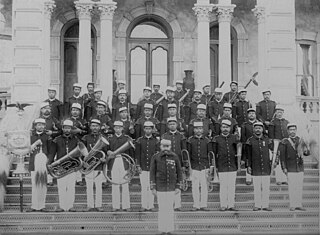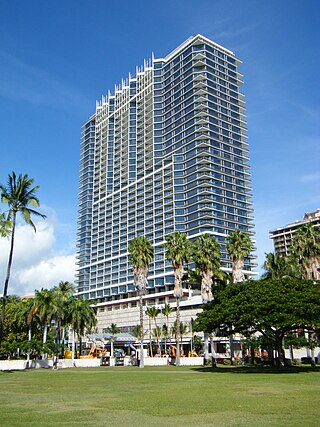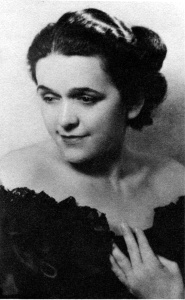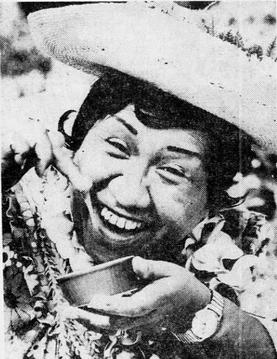Related Research Articles

Waikīkī is a Honolulu neighborhood and the eponymous Waikīkī beach on its south shore, on the island of Oʻahu in the U.S. state of Hawaii. Despite popular perception and frequent marketing materials to the contrary, the use of the kahakō is both official and commonly used.
The music of Hawaii includes an array of traditional and popular styles, ranging from native Hawaiian folk music to modern rock and hip hop. Styles like slack-key guitar are well known worldwide, while Hawaiian-tinged music is a frequent part of Hollywood soundtracks. Hawaii also made a contribution to country music with the introduction of the steel guitar. In addition, the music which began to be played by Puerto Ricans in Hawaii in the early 1900s is called cachi cachi music, on the islands of Hawaii.

Philip Kunia Pahinui, known as Gabby Pahinui, was an American Hawaiian slack-key guitarist and singer of Hawaiian music. He also went by Pops Pahinui.

Diamond Head is a volcanic tuff cone on the Hawaiian island of Oʻahu. It is known to Hawaiians as Lēʻahi, which is most likely derived from lae plus ʻahi (tuna) because the shape of the ridgeline resembles the shape of a tuna's dorsal fin. Its English name was given by British sailors in the 19th century, who named it for the calcite crystals on the adjacent beach.

The Royal Hawaiian Band is the oldest and only full-time municipal band in the United States. At present a body of the City & County of Honolulu, the Royal Hawaiian Band has been entertaining Honolulu residents and visitors since its inception in 1836 by Kamehameha III. During the monarchy it was nominally a military band. It reached global prominence under the leadership of Prussian Heinrich "Henri" Berger, an officer of the imperial German army loaned to the Kingdom of Hawaiʻi in 1872. Berger composed many beloved marching tunes and other melodies, and would later be honored with the title of "Father of Hawaiian Music." He collaborated with King Kalākaua in creating Hawaiʻi Ponoʻi, the national anthem of Hawaiʻi; it is still used today as the official state song.

Queen Kapiʻolani Regional Park is the largest and second-oldest public park in Hawaii, located in Honolulu on the east end of Waikiki just beyond Kuhio Beach Park and the Waikiki residential neighborhood. The 300-acre (1.2 km2) park, named after Queen Kapiʻolani, the queen consort of King David Kalākaua, is home to the Waikiki Shell and the Honolulu Zoo.

Ka Laʻi Waikiki Beach, formerly the Trump International Hotel Waikiki, is a condo-hotel in Honolulu, Hawaii. The hotel is part of the LXR Hotels & Resorts division of Hilton Hotels & Resorts. It is 350 ft (110 m) tall, 775,000 sq ft (72,000 m2) tower with a total of about 462 units. The building includes a spa and dining space, as well as a fitness center, library, lobby bar, cafe, parking and 6th floor ocean view residential and hotel lobby.
Peter Moon was an American ukulele and slack-key guitar player.
Herb Ohta aka Ohta-san is an American Ukulele player born in 1934 in Hawaii who has recorded solo, as a group and with Andre Popp on the A&M Records label, which was co-owned by Herb Alpert and Jerry Moss. He is also known as "Ohta-san" in Japan and other Asian countries, which is a title of respect for the musician.

Eric Lee is a Hawaiian musician, singer, songwriter, and producer. His work has appeared on more than 30 albums, including his work with The Kanile'a Collection, Nā Kama, The Ka'ala Boys, The Mākaha Sons, and his solo albums, Crossroads, Kawehilani, and his Twentieth Anniversary Anthology.

The Hawaiian Music Hall of Fame is an organization dedicated to recognizing the cultural importance of the music of Hawaii and hula. Established in 1994, the Hawaiian Music Hall of Fame promotes the appreciation and preservation of Hawaiian culture through educational programs and annual inductions honoring significant individuals, groups, institutions, chanters and songs.
Lyle Joseph Ritz was an American musician, known for his work on ukulele and bass. His early career in jazz as a ukulele player made him a key part of the Hawaii music scene in the 1950s. By the 1960s, he had begun working as a session musician, more often on double bass or electric bass guitar. His prominence in the Los Angeles session scene made him a part of the Wrecking Crew, an informal group of well-used Los Angeles–based musicians. Ritz contributed to many American pop hits from the mid-1960s to the early 1980s. Starting in the mid-1980s, a rediscovery of his earlier ukulele work led to him becoming a fixture in live festivals, and a revival of his interest in playing the ukulele. He was inducted into both the Ukulele Hall of Fame Museum and the Musicians Hall of Fame and Museum in 2007.
Roy Sakuma is a ukulele teacher, credited for sparking new generations of ukulele players and virtuosos like Jake Shimabukuro who got his start as a young student at Roy Sakuma Studios. Sakuma launched what is considered to be the first major ukulele festival in 1971, an annual event in Honolulu that continued for 52 years.
The following is a timeline of the history of the city of Honolulu, on Oahu, in the U.S. state of Hawaii.

Lena Machado was a Native Hawaiian singer, composer, and ukulele player, known as "Hawaii's Songbird". She was among the first group of musical artists honored by the Hawaiian Music Hall of Fame in 1995. Noted for her use of the Hawaiian vocal technique of "ha'i," which emphasizes the transition between a singer's lower and falsetto vocal ranges, and her use of "kaona" when writing song lyrics, she entertained primarily in Hawaii and the mainland United States. She sold leis on the Honolulu piers as a child, and aspired to become a singer like the women she saw greeting incoming passengers. KGU radio manager Marion A. Mulroney discovered her as she sang in a mango tree next door to his home. She performed regularly on KGU, where Royal Hawaiian Band conductor Mekia Kealakaʻi heard her and hired her as a featured soloist in 1925. Her association with the Royal Hawaiian Band would last five decades. During World War II, she had her own radio show on KGU.

Myrtle Keahiʻaihonua Kalanikahea Hilo was a native Hawaiian taxicab driver, radio personality, ʻukulele player and singer. Her signature album The Singing Cab Driver was released in 1967 on Makaha Records. She was born in Hauʻula, Hawaii on the island of O'ahu. In 1998 she received the Lifetime Achievement Award from the Hawai'i Academy of Recording Arts.

Taimane Tauiliili Bobby Gardner, who often performs under the mononym Taimane, is an American ukulele virtuoso and composer. In 2019, she won a Nā Hōkū Hanohano award, for Favorite Entertainer of the Year. In 2019, Taimane Gardner's song, Water, from her album, Elemental was nominated for Instrumental Composition of the Year by Nā Hoku Hanohano Awards.

Walter Le Montais Giffard was a Hawaiian diplomat and a member of Liliʻuokalani's Privy Council of State. He was born on the Island of Jersey in Great Britain and moved to Hawaii at a young age, working his way up through the W. G. Irwin & Co., Ltd organization to partnership and trustee. Giffard was one of the consulting landscape architects for the grounds of the Royal Hawaiian Hotel in Waikiki. He was influential in the agricultural quarantine to protect Hawaii's sugar cane fields, and helped introduce the Yellow Caledonia cane to the growers.

Danny "Kaniela" Kaleikini was an American singer, musical artist, and entertainer. Best known for his long-term residency at the Kahala Hilton in Hawaii, where he performed for 28 years, Kaleikini is often called "The Ambassador of Aloha". During his career of more than 50 years in show business, he was the opening act for Paul Anka at Caesars Palace in Las Vegas, and performed alongside Sammy Davis Jr., Wayne Newton, Dolly Parton, Phyllis McGuire, and Don Ho. A baritone who sang Hawaiian songs and played the nose flute, Kaleikini gained international recognition for promoting Hawaiian music, language, and culture.

The Kahala Hotel & Resort is a luxury hotel on the island of Oahu in the state of Hawaii. It first opened in 1964 as the Kahala Hilton. Developed as an exclusive retreat away from Waikiki, the resort became a popular destination for celebrities such as Frank Sinatra and Elton John; foreign dignitaries including Queen Elizabeth II, the Reverend Desmond Tutu, and the Dalai Lama; and eight United States presidents. In the mid-1990s, it was renamed the Kahala Mandarin Oriental and was later known simply as The Kahala. The resort has had captive dolphins or porpoises in its private lagoon since its first year of operation.
References
- ↑ Berger, John (July 20, 2022). "Strumming the final chords". Honolulu Star-Advertiser. pp. D1, D6. Retrieved 2023-01-08– via Newspapers.com.
- 1 2 Tranquada, Jim (2011). The Ukulele: A History. Honolulu, Hawaii: University of Hawaii Press. p. 157. ISBN 9780824836344.
- ↑ Donnelly, Dave (July 20, 1972). "Dave Donnelly's Hawaii". Honolulu Star-Bulletin. p. A-4. Retrieved 2023-01-08– via Newspapers.com.
- ↑ "Ukulele festival has global mix of musicians". Honolulu Star-Advertiser. July 14, 2017. p. T2. Retrieved 2023-01-08– via Newspapers.com.
- 1 2 Berger, Ukulele fest strums along, Honolulu Star Bulletin, Friday, July 23, 2004
- 1 2 3 4 5 The 27th Annual Ukulele Festival Report
- ↑ After 125 years, the ukulele still keeps people smiling
- ↑ The `Ukulele Archived August 1, 2013, at the Wayback Machine
- ↑ Ukulele Festival set for Sunday in Waikiki
- ↑ PRI's The World Archived August 23, 2011, at the Wayback Machine
- ↑ The Syracuse Post Standard, July 18, 2011
- ↑ Roy Sakuma’s Ukulele Festival 2011 Archived September 30, 2013, at the Wayback Machine
- ↑ Ukulele Festival Hawaii 2013